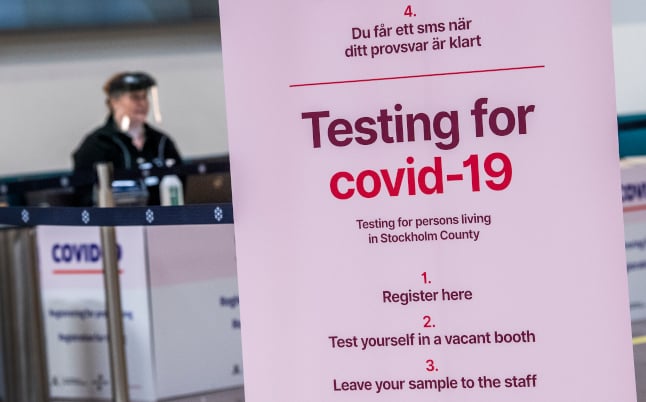This recommendation also applies to Swedish citizens and residents, regardless of which country (outside the other Nordic countries Denmark, Norway, Finland and Iceland) they travelled from. It is free to get tested if you are arriving in Sweden from overseas.
The change was issued by the Public Health Agency on Monday, applies from July 12th until August 31st, and follows similar recommendations earlier in spring.
The guidelines are being reintroduced due to lifted restrictions and an increasing spread of the infectious Delta variant of the coronavirus in popular tourist destinations in Europe and other parts of the world.
“The Swedish Public Health Agency has received reports of several cases of Covid-19 where people were infected in connection with nightlife abroad in nightclubs, pubs and places where new contacts are made. This in turn increases the risk of spread of infection and outbreaks in Sweden, where the domestic spread of Covid-19 is now at a low level,” said state epidemiologist Anders Tegnell in a statement.
He told a press conference on Monday that it was mainly people living in Sweden who were bringing the infection home, rather than foreign tourists spreading the virus, but the recommendation applies to everyone regardless of their reason for travelling or returning to Sweden.
The recommendation comes amid concerns of the rise of the Delta variant of coronavirus, which is more infectious. The first dose of a Covid-19 vaccine appears to offer less protection against Delta than against other variants, although two doses offer good protection.
The Public Health Agency has previously predicted that the Delta variant will become the dominant variant in Sweden in the coming months. The spread of the variant is increasing, with more than 1,800 confirmed cases, although the total number of new Covid-19 cases is still falling in Sweden.
Not all countries are seeing falling rates of the virus, however, and in neighbouring Denmark they have been on the increase for almost two weeks, with Delta making up the majority of new cases. The Local’s reporter Isabella Anderson asked Tegnell at the press conference on Monday why the Nordic countries were exempt from the tightened testing guidelines, with no restrictions currently applying to travel from the Nordics.
“These are countries (…) that have very low spread of infection even though it’s increasing, so in this situation we think it is reasonable to exempt these countries from which travel is so extensive that it’s practically very, very difficult to follow this kind of advice. We try to avoid advice that can’t be followed, and considering all the movement of labour across these borders, you can’t practically keep testing like that,” said Tegnell, adding: “That Denmark has very high numbers is probably partly due to the fact that they are testing an enormous lot at the moment, so I don’t think the situation there is at all comparable to what you’re seeing in Spain, the Netherlands, Portugal.”
You can listen to The Local’s questions at the press conference (in Swedish) here, from 37:30:
People who have been travelling within the EU and received their first dose at least three weeks before arriving in Sweden or had Covid-19 in the past six months, are exempt from the recommendation. They should however get a coronavirus PCR test if they develop symptoms.
The Public Health Agency also advises travellers to “be careful about who you meet” the week after returning to Sweden, and in particular avoid meeting risk groups. “If you are infected you risk spreading the infection at, for example, your workplace and to your closest circle. For that reason, pay very close attention to mild symptoms and keep a physical distance,” the recommendation states.
ALSO TODAY: Sweden to go ahead with Covid-19 rules relaxation from mid-July
Depending on where you’re travelling from, you may have to follow even stricter guidelines. Travellers from most non-EU countries (i.e. a country that is outside the EU/EEA and is not on the EU’s list of exempted third countries), are as before additionally urged to get a second test on the fifth day after arriving in Sweden, and self-isolate for seven days after arriving even if the tests show they don’t have Covid. Fully vaccinated travellers (with vaccines approved by the EMA or the WHO’s emergency authorisation) are however exempt from this.
Unlike tests for people who want to travel abroad from Sweden, PCR tests for returning travellers are free for everyone and available via the healthcare system, Tegnell told a press conference on Monday. They can be ordered via healthcare website 1177.se.
It is important to note that the recommendations in this article refer to what happens after you’ve arrived in Sweden. Sweden also has several border restrictions in place, which regulate who is allowed to enter the country at all and what kind of documentation you need to show. These rules vary depending on where you travel from, and may include the Covid-19 health pass, a PCR test, or your reason for travel.
For more information:
- Public Health Agency guidelines on testing and isolation (in English)
- Government Questions and answers about the entry ban to Sweden (in English)
- Entry ban FAQ from the Swedish police (in English)



 Please whitelist us to continue reading.
Please whitelist us to continue reading.
Member comments